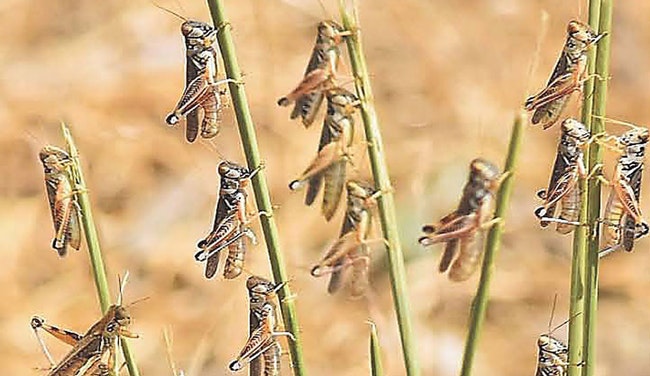
State officials are expecting a severe outbreak of grasshoppers like these, as well as Mormon crickets a type of katydid that can devastate range plants. (Oregon Department of Agriculture photo)
Agriculture officials and eastern Oregon landowners are gearing up for another big grasshopper infestation this year, but there’s a new effort that could help curb the spread of the range-devouring pests.
The state Legislature in 2021 approved $5 million for a program to combat the infestation of grasshoppers and Mormon crickets across Oregon, including areas of Malheur County. More than $4 million of that is earmarked for suppression and treatment of outbreaks, with the balance aimed at pre-treatment work and post-treatment surveys.
The expected hopper population boom follows last year’s outbreaks, which the Oregon Department of Agriculture described as the worst in 50 years, and an outbreak the year before that was tagged “historic.”
“We haven’t had anything like this since the ’80s,” said Todd Adams, an ODA entomologist with the grasshopper survey program.
The culprit is drought, which provides optimal conditions for hatching and survival of the immature hoppers.
The infestations are a concern because the insects devour forage and range plants needed for livestock and wildlife, and also damage food crops when they spread into farm lands.
Adams is encouraging landowners who believe they have an outbreak and want to get help to go online to the department website and fill out an outbreak reporting form.
The next step would be an onsite survey by program officials to assess the problem and advise the landowner of options for treatment. Landowners who pursue an approved treatment plan can qualify for a cost-sharing program that reimburses costs.
The current treatment regimen is aerial application of the insecticide Diflubenzuron, which is approved by the U.S. Department of Agriculture to control grasshoppers and Mormon crickets. However, it must be applied early in the season when the insects are growing, as the adult insects are not affected by it.
Adams said Mormon crickets have begun hatching this season, while grasshoppers emerge later in the season.
The agriculture agency says there are more than 100 species of grasshoppers in Oregon, although only 10 are identified as “important pests” for rangeland and agriculture.
Mormon crickets are not grasshoppers or even true crickets, but wingless katydids. Their outbreaks can last five to 21 years, a duration affected largely by weather conditions. A wet, cold spring – unlike this year’s dry conditions – promotes disease and other factors that hamper outbreaks.
In Malheur County, a Mormon cricket outbreak in the Jordan Valley is believed to have spread from Idaho. Crickets found in the McDermitt area at the county’s southern border apparently came out of Nevada.
Adams said unlike grasshoppers, Mormon crickets can travel great distances, moving up to 50 miles in one year.
Learn more about reporting
Adams said an overview about the reporting form and process will be offered online at 10 a.m. Pacific Time on Friday, April 15. Following is the sign-in information:
Microsoft Teams meeting
Join on your computer or mobile app
Click here to join the meeting
Or call in (audio only)
+1 503-446-4951,,884327121# United States, Portland
Phone Conference ID: 884 327 121#
Find a local number | Reset PIN
EXCELLENCE IN JOURNALISM – Available for $5 a month. Subscribe to the digital service of the Enterprise and get the very best in local journalism. We report with care, attention to accuracy, and an unwavering devotion to fairness. Get the kind of news you’ve been looking for – day in and day out from the Enterprise.




